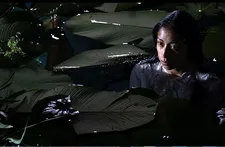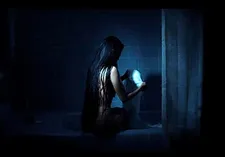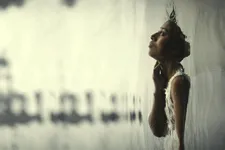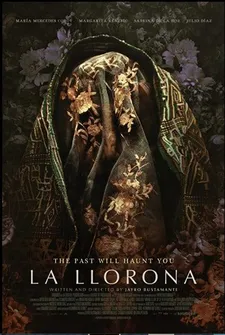 |
| Jayro Bustamante on his Oscar shortlisted and Golden Globe nominated La Llorona: “There are a lot of things coming from the classic mythology.” |
Jayro Bustamante deftly and imaginatively places his La Llorona (co-written with Lisandro Sanchez) at the intersection of history and legend. The ancient tale of the weeping woman who has haunted Latin American childhoods for centuries, here gains footing in recent Guatemalan history. General Enrique (Julio Diaz), now an old man, is among those on trial for the genocide of thousands. In 1982/83 one third of the Mayan population in Guatemala were exterminated, 38% were children under 12. Enrique’s wife Carmen (Margarita Kenéfic), daughter Natalia (Sabrina De La Hoz), granddaughter Sara (Ayla-Elea Hurtado), and Valeriana (María Telón), the only servant who remains loyal in the house, have to open their eyes to the family legacy.
 |
| Jayro Bustamante on Alma (María Mercedes Coroy): “I give to my Llorona that princess aspect, Mayan princess I mean.” |
Whispers begin the film (shot shrouded in mystery by Nicolás Wong) and we cannot tell for certain if what we are witnessing is a wake or a séance among four generations of women. Meanwhile the men discuss outfits for the trial. “You must look flawless,” we hear. Dark suits, but “not black”, “impeccable white shirts” with double Windsor knots; and “remember, you are heroes, not victims, don’t lower your heads.” From the start it is clear that this is a place of divides - of gender and class and don’t you dare to question it. Is the villa haunted? Do Valeriana’s prayers to the ancestors work? Why is the “master of the house” wandering the corridors at night while the water is running?
Anyone familiar with the lore knows that the farther away La Llorona sounds, the closer she is. A woman, her face covered in blue and golden embroidery, testifies of the horrors during the trial. Protesters hold up crosses and pictures of their dead in front of Don Enrique’s house. A new maid Alma (María Mercedes Coroy) appears out of the crowd. She bonds with Sara and teaches her how to hold her breath under water. Nightmares abound. History and its crimes take a toll. The weeping women have an abundance to weep about.
From Guatemala City, Jayro Bustamante joined me on Zoom for a conversation on La Llorona.
Anne-Katrin Titze: First of all congratulations on your Golden Globe nomination and being Oscar shortlisted! Well deserved!
 |
| Jayro Bustamante: “La Llorona in a way came and possessed the women of the film to break that system.” |
Jayro Bustamante: Thank you. You know, it’s very important news for us. This is the first time for my country and for the Central American region to have that kind of nomination and to be in the shortlist of films. And for the Golden Globes it’s the first time that a country as mine, which is a very small one, is representing the whole Latin American people. We’re trying to learn, because it’s our first time. That experience means work, means understanding the whole industry. We are trying to learn so we can teach afterwards to others.
AKT: There were moments in you film where I was reminded of a Mexican film from 1960 that was nominated for an Oscar. I am thinking of Macario.
JB: For sure.
AKT: Roberto Gavaldón also based his film on a traditional tale, that of Godfather Death [collected by the Brothers Grimm]. What I like so much about your film is that you take this ancient legend that has so many different variations and you connect it with the history of your country. Did you grow up with the tale of the weeping woman? How did it come about that you combined the two?
JB: Sure we grew up with her. In Latin America she is so important. But the real myth changed a lot during history. Because at the beginning for most American people La Llorona was a princess or a divinity who cried each time that she had a premonition about bad things happening to her people.
 |
| Jayro Bustamante: “For Mayans water is a way to clean all the suffering and you have to cross a water frontier to be reborn.” |
AKT: Like Cassandra!
JB: Exactly. And afterwards when the Spanish came and the conquest was made, they changed the myth and La Llorona became a legend to determine women’s comportment. So La Llorona became a very misogynistic, machismo legend because it’s about an indigenous woman who cries because a white man leaves her. And she arrives at killing her children because she is so sad about a man. And in a way I wanted to change that and say - La Llorona has another, more relevant thing to cry over than a man. That can be a genocide that really happened. That was the way we followed to write that film.
AKT: And you still keep parts of the mythology intact, such as “the closer she sounds, the farther away she is [and vice versa].”
JB: There are a lot of things coming from the classic mythology. All the water, all the humidity, all the frogs in the story. All that came from the real legend. Because for Mayans water is a way to clean all the suffering and you have to cross a water frontier to be reborn. So for me it was important to be able to keep it as a fairy tale. For example frogs were an element in fairy tales. Normally you don’t know who is behind a frog.
AKT: Right.
 |
| La Llorona poster |
JB: You are watching this in that ugly shape because you don’t want to accept the other. And in a way the characters in my film are watching frogs but they are not frogs, they are souls from people who disappeared.
AKT: Very powerful, it works extremely well. Also what you do at the very beginning, the first scene where we don’t know if we are watching a funeral or a séance. And the figure dressed in white already there - you might think of Jesus. Also the separation of the women and the men talking business attire. A pristine white shirt, a dark suit, not black. How did you come up with that beginning?
JB: You know, there’s two reasons. The first one and the big idea was my General is not just representing the dictators from Guatemala, he is representing that phallocratic system that we have to work to break. And La Llorona in a way came and possessed the women of the film to break that system. That was one reason and the other one was that La Llorona is always represented in movies as a monster. And I wanted to represent her as a princess, you know, as Dracula. Dracula is always represented in a very elegant way, even Satanás in some films. So I give to my Llorona that princess aspect, Mayan princess I mean.
AKT: I can see that.
JB: Also, for the first scene, what is classical in all the horror stories - you have to invite the element, the horror element to come in the house.
AKT: Yes, the devil cannot get over the threshold unless you say “Come on in!”
JB: Exactly. So these women are making this prayer, saying “come in my house, take my body, take my hands, take my voice and protect me.” And La Llorona came to protect her. Even if at the end we kill the man, it is a way to protect that group of women and the whole community.
 |
| Jayro Bustamante on General Enrique (Julio Diaz): “Even if at the end we kill the man, it is a way to protect that group of women and the whole community.” |
Coming up - More of my in-depth conversation with Jayro Bustamante on La Llorona.
The Golden Globe Awards ceremony will take place on February 28 from The Beverly Hilton Hotel.
Oscar nominations will be announced on Monday, March 15, 2021. The Academy of Motion Picture Arts and Sciences (AMPAS), will honor the best films released between January 1, 2020, and February 28, 2021.
The 93rd Academy Awards ceremony will be held on Sunday, April 25, 2021, at the Dolby Theatre at Hollywood & Highland Center in Hollywood, and will be televised live on the ABC Television Network. The Oscars also will be televised live in more than 225 countries and territories worldwide.





















